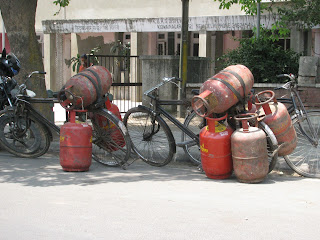Lesa joined Pradeep and me on our third day of location filming last week. It was a scheduled shoot to film Champa the elephant and her mahout, Akram. Lesa came along to see what our documentary project was all about. We gladly put her to work. She helped with lighting and sound and provided us with a little moral support. On this particular day we followed Champa on her route to a nearby sugar cane field. We wanted to capture the process of how this favorite elephant-fodder was cut, gathered and loaded. Akram offered Lesa a ride on Champa's back on the way to the fields - of course she didn't hesitate to accept...

After about a three kilometer walk, we arrived at farmers' fields. We set up for filming, but it wasn't long before Lesa somehow got side-tracked... It's not that she wasn't interested in what we were doing... in all honesty, watching a man cut down 300 kilos of sugarcane is a pretty dull, repetitive experience. All we really needed was a few minutes of good footage, but the process took over 2 hours in the hot sun... Of course this is India, and no matter where you are, there are always people, and there is always something going on... The locals caught her eye, and Lesa got lost for time in the activities of the little village.
First it was babies. Two sisters insisted that she hold a young infant, named Ismail. They were very happy about it - they giggled and commented about the attention Lesa gave to their cute baby. As she held him, Ismail promptly smiled up at Lesa, which made the two sisters laugh and giggle even more. It was a nice connection.
After she gently handed the baby back to her mother and auntie, Lesa then made the mistake of showing interest in what another nearby woman what was planting.
We were standing in a sandy flood plain at the edge of the Yamuna River. The soil was neatly tilled with rows of little ridges for planting seeds. Once she understood what my wife was asking, the woman showed Lesa a container of small seeds - red lentils (dal). She led Lesa by the elbow out into the field and demonstrated how to plant the lentils. She placed one seed in each of many prepared holes along the tilled rows of dry, sandy soil.
Her husband was obviously amused at the sight of "Madame-Ji" learning how to plant lentils. He walked over and with a mix of Hindi, hand gestures and a few English words, explained that, once planted, he would flood the field by opening a channel from a small irrigation canal nearby. The husband and wife were a cute, surprisingly loving couple. They clearly cared for one another.
Without hesitation, and with plenty of laughter and encouragement, the couple set Lesa to work planting seeds. Twenty minutes of planting was enough for Lesa. Stooping in the hot sun has it's limitations. But I'm sure her participation in the day's planting gave the farmers a great story to share with their neighbors in the village that evening!
The photo shoot was finished and Champa, with Akram's guidance, had loaded herself with hundreds of kilos of cane. The three of us stowed our equipment and said our goodbyes...
But before we left, the farmer's wife returned with a big generous smile on her face. She handed Lesa a bundle of beautiful, fresh white radishes - a gift for "Madame-Ji," and many thanks for her help in planting the lentil crop.































